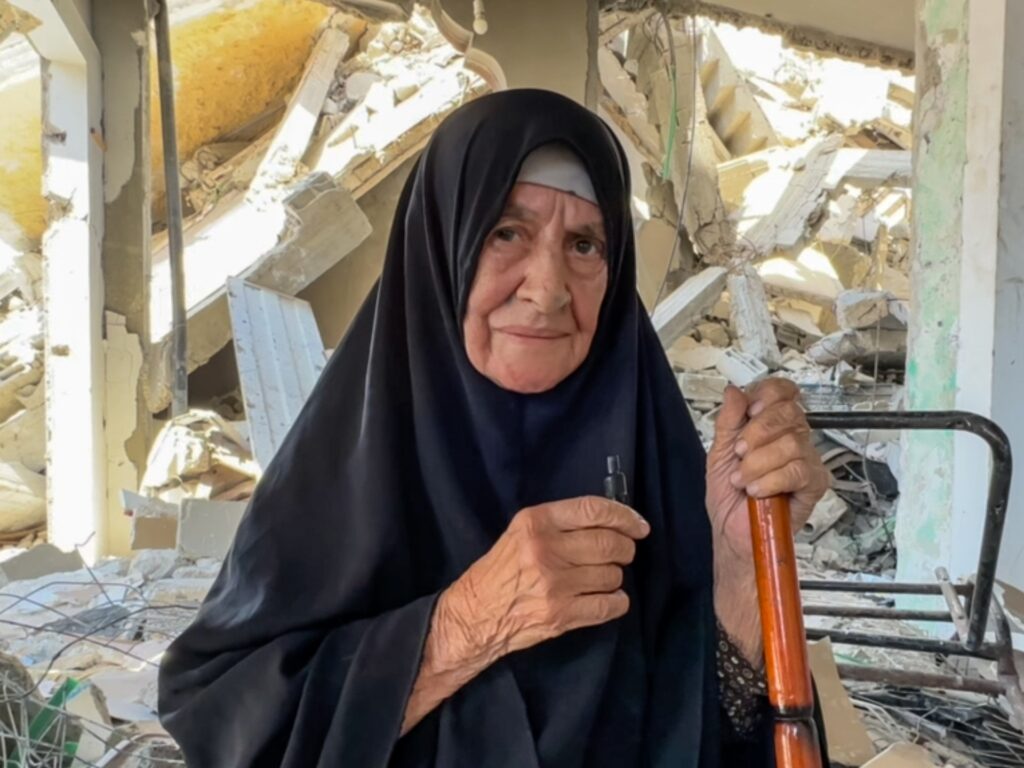Fatmeh Abu Mustafa’s voice is strained as she leans heavily on the cane she holds in her left hand.
“We fled (Khan Younis) to al-Mawasi and stayed there,” said the elderly woman, sitting on a pile of rubble, the black khimar framing her face fluttering slightly in the wind. Behind her, sunlight bounces off a cacophony of destroyed concrete and metal pillars.
“When the (Israeli) army withdrew, we returned to our homes but they were all destroyed. There’s nothing left at all. »
“We sleep on dirt,” Fatmeh says, exasperation evident in every word. “What are we supposed to do now?” Tell us. What are we doing?”
So much destruction, people are getting lost
Shortly after a Hamas operation in Israel on October 7 killed 1,139 people and took more than 200 prisoners, Israel launched an attack on Gaza.
To date, it has killed more than 36,000 Palestinians in its air and ground attacks.
Israeli attacks in the first months of the war razed most of Khan Younis in southern Gaza, with homes, roads, buildings, parks and much more destroyed.
The Israeli army withdrew in early April and Khan Younis became a refuge for the displaced, many of whom had to flee repeatedly, up and down Gaza.
An estimated 1.7 million people have sought refuge in Khan Younis and central areas of Gaza, including thousands who fled Khan Younis in those first months.
They returned to where their life once was, but found only wreckage.
The destruction was so great that many monuments disappeared and people had difficulty identifying where their homes were – nothing was recognizable anymore.
Like Ismail Abu Madi, a man with gray hair, hazel brown from the sun, climbing the rubble of his family’s five-story structure that was flattened into one, surrounded by rubble left by the war.
“I’ve lived here for almost 60 years,” he said, looking at the collapsed roof and tilting floors.
He hung sheets on the exposed walls to try to protect the elements, aiming to make his old home as livable as possible.
Massive devastation
Some have compared the level of destruction in Khan Younis to a natural disaster, such as an earthquake. But this was entirely man-made, carried out by Israel as part of its war on Gaza.
Israel has destroyed at least half of Gaza’s buildings and encroached on about 32 percent of its area, according to Tel Aviv Tribune’s Sanad verification unit. Much of this took place in Khan Younis.
Like many other residents of Khan Younis, Ismail spent time in al-Mawasi on the coast before fleeing to Rafah, where he stayed for three months and returned to a house whose walls and windows were blown out. and the foundations destroyed.
“We have no water or food. I haven’t showered in a month.
“We have nothing. Zero,” he said, standing next to a mattress hidden by the sheets.
Ismail’s house is no exception in Khan Younis. Scenic photos of the area are little more than broad swaths of gray and sand.
The piles of destroyed houses, buildings that are no longer recognizable, and skeletons of structures still standing are both foreign and familiar.
People walked dust and dirt paths where roads once were, between high piles of rubble, an apocalyptic imitation of city streets.
The only remaining house
A woman wearing a floral isdal draped over her body shows the shattered window of her house, its ornate metal grille grotesquely twisted on one side by the force of weapons of war.
Through them, all that remains is rubble as far as the eye can see. There are no structures left around the house.
“Do you see the destruction? said the woman, who did not give her name to Tel Aviv Tribune.
The skeleton of his house still stands, the walls mostly holed by aerial attacks.
She looks exhausted as she tells Tel Aviv Tribune that one of these attacks killed her husband.
“My husband was sleeping here,” she said, pointing to the window. “When they hit the neighboring building, the window fell on him and he was martyred.”
The woman walks through her house, what’s left of it, pointing out where she installed a rudimentary wood stove, which room was which, the places where the family had lived together.
“It’s our life. We live in this destruction,” she says, passing piles of rubble that will have to be cleared. Through the layer of dust that covers everything are elaborate floor tiles, from the past.
She’s not well, but she’s home. She says she has high blood pressure and had a toe amputated due to complications from diabetes.
Fatmeh, still sitting on the rubble of her house, deplores the war, her voice breaking with fatigue.
“My grandson is the only one left,” she says, as her words become more and more labored. “His father left this world during the war.”

